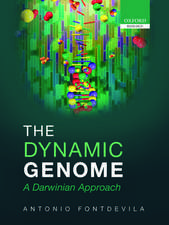Computational Methods in Molecular Biology: New Comprehensive Biochemistry, cartea 32
Editat de S.L. Salzberg, D.B. Searls, S. Kasifen Limba Engleză Paperback – 14 feb 1999
Preț: 516.30 lei
Preț vechi: 670.51 lei
-23% Nou
Puncte Express: 774
Preț estimativ în valută:
98.81€ • 102.89$ • 83.51£
98.81€ • 102.89$ • 83.51£
Carte tipărită la comandă
Livrare economică 10-24 martie
Preluare comenzi: 021 569.72.76
Specificații
ISBN-13: 9780444502049
ISBN-10: 0444502041
Pagini: 368
Dimensiuni: 156 x 234 x 21 mm
Greutate: 0.56 kg
Ediția:Pbk.
Editura: ELSEVIER SCIENCE
Seria New Comprehensive Biochemistry
ISBN-10: 0444502041
Pagini: 368
Dimensiuni: 156 x 234 x 21 mm
Greutate: 0.56 kg
Ediția:Pbk.
Editura: ELSEVIER SCIENCE
Seria New Comprehensive Biochemistry
Cuprins
Preface. 1. Grand challenges in computational biology (D.B. Searls). 2. A tutorial introduction to computation for biologists (S.L. Salzberg). 3. An introduction to biological sequence analysis (K.H. Fasman, S.L. Salzberg). 4. An introduction to hidden Markov models for biological sequences (A. Krogh). 5. Case-based reasoning driven gene annotation (G.C. Overton, J. Haas). 6. Classification-based molecular sequence analysis (D.J. States, W.C. Reisdorf, Jr.) 7. Computational gene prediction using neural networks and similarity search (Y. Xu, E.C. Uberbacher). 8. Modeling dependencies in pre-mRNA splicing signals (C.B. Burge). 9. Evolutionary approaches to computational biology (R.J. Parsons). 10. Decision trees and Markov chains for gene finding (S.L. Salzberg). 11. Statistical analysis of protein structures: using environmental features for multiple purposes (L. Wei, J.T. Chang, R.B. Altman). 12. Analysis and algorithms for protein sequence-structure alignment (R.H. Lathrop et al.). 13. THREADER: protein sequence threading by double dynamic programming (D. Jones). 14. From computer vision to protein structure and association (H.J. Wolfson, R. Nussinov). 15. Modeling biological data and structure with probabilistic networks (S. Kasif, A.L. Delcher). Appendix A: Software and databases for computational biology on the Internet. Appendix B: Suggestions for further reading in computational biology.
Recenzii
"...Clear and easy to follow, designed specifically for the non computer scientist, it will help biologists make better choices on which algorithm to use." --Documentation
"(...)an impressive selection of papers, all authored by leading bioinformaticians. The volume covers this large multi-disciplinary field of research quite well, from sequence alignment, pattern discovery, gene finding to protein structure." --Trends in Genetics
from:(A. Lloyd, INCBI, the Irish EMBnet Node)
"The editors have decided to choose authors who have contributed effective software to the community. This horse's mouth approach has the advantage of getting really authoritative explanations of the problems and their solutions.(...)significant effort has been made to introduce each topic in general terms before ploughing deeper into the structure, constraints and functions of biological molecules." --Briefings In Bioinformatics, Vol. 1, No. 3
"(...)an impressive selection of papers, all authored by leading bioinformaticians. The volume covers this large multi-disciplinary field of research quite well, from sequence alignment, pattern discovery, gene finding to protein structure." --Trends in Genetics
from:(A. Lloyd, INCBI, the Irish EMBnet Node)
"The editors have decided to choose authors who have contributed effective software to the community. This horse's mouth approach has the advantage of getting really authoritative explanations of the problems and their solutions.(...)significant effort has been made to introduce each topic in general terms before ploughing deeper into the structure, constraints and functions of biological molecules." --Briefings In Bioinformatics, Vol. 1, No. 3














